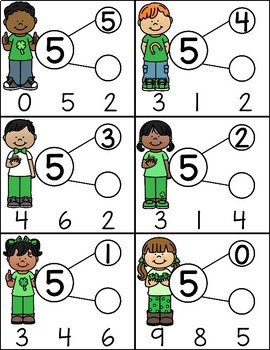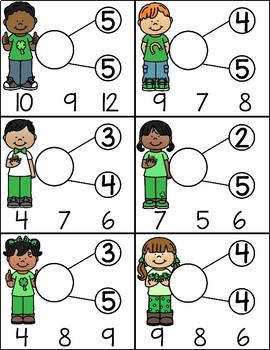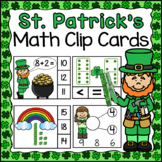St. Patrick's Day Math Number Bonds
Herding Kats in Kindergarten
9.7k Followers
Grade Levels
K - 1st
Subjects
Resource Type
Standards
CCSSK.OA.A.5
CCSS1.OA.C.6
Formats Included
- PDF
Pages
14 pages
Herding Kats in Kindergarten
9.7k Followers
Also included in
- St. Patrick's Day Math Clip Cards Bundle *Special Price for First 24 hours*This bundle contains the addition clip cards, number bond clip cards, place value and comparing number clip cards for St. Patrick's Day! Each set comes with clothespin clip cards, as well as differentiated recording sheets. CPrice $6.00Original Price $7.50Save $1.50
Description
St. Patrick's Day Number Bonds: This is a fun math activity for learning number bonds, Students use clothespins to mark the correct whole or part to complete the number bond. If you place a small sticker on the back of the card behind the correct answer this becomes a self-checking activity!
Included:
36 cards with missing parts for sums to 10
12 cards for sums to 10
12 cards for sums to 5
4 differentiated recording sheets
You Might Also Like:
• St. Patrick's Day Activities for Addition & Subtraction
• St. Patrick's Day Activities for Math
• St. Patrick's Day Activities for Measurement
• St. Patrick's Day Activities: Sight Word Game
Total Pages
14 pages
Answer Key
N/A
Teaching Duration
N/A
Report this resource to TPT
Reported resources will be reviewed by our team. Report this resource to let us know if this resource violates TPT’s content guidelines.
Standards
to see state-specific standards (only available in the US).
CCSSK.OA.A.5
Fluently add and subtract within 5.
CCSS1.OA.C.6
Add and subtract within 20, demonstrating fluency for addition and subtraction within 10. Use strategies such as counting on; making ten (e.g., 8 + 6 = 8 + 2 + 4 = 10 + 4 = 14); decomposing a number leading to a ten (e.g., 13 - 4 = 13 - 3 - 1 = 10 - 1 = 9); using the relationship between addition and subtraction (e.g., knowing that 8 + 4 = 12, one knows 12 - 8 = 4); and creating equivalent but easier or known sums (e.g., adding 6 + 7 by creating the known equivalent 6 + 6 + 1 = 12 + 1 = 13).






